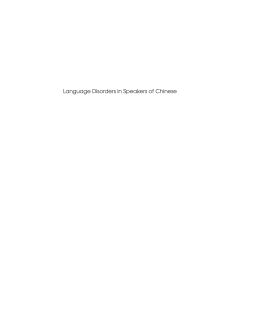
BOOK
Language Disorders in Speakers of Chinese
Sam-Po Law | Dr. Brendan Weekes | Anita M-Y Wong
(2008)
Additional Information
Book Details
Abstract
Research interest in Chinese language impairments can be traced back to the 1930s. Despite the significant advances made in this research field over the past two decades, this body of work has not received the attention it deserves. This book fills a gap in the field and represents the latest research in Chinese language disorders in children and adults. The work presented in this volume addresses theoretical and clinical issues relevant to specific language impairment in children, developmental dyslexia, phonological impairment in children and adults, and acquired dyslexia and dysgraphia. The book will appeal to interdisciplinary researchers from cognitive psychology, linguistics, and neurology with interests in the Chinese language, speech-language therapists working with Chinese-speaking clients, educationists, in particular language teachers of children learning to read and write Chinese, as well as neuroscientists. It will serve as a good reference book for advanced level undergraduate courses or graduate courses in speech/language pathologies and psycholinguistics.
Lucid, conceptually rich and clinically useful, this volume probes areas of childhood and adult communication disorders where Chinese may differ interestingly from the more-studied languages in our field.
Loraine K. Obler, Distinguished Professor, Program in Speech-Language-Hearing Sciences, CUNY Graduate Center
Splendid! This volume, with its timely topic, reputable editors, and outstanding contributors, not only fills an existing gap but also breaks new ground in the comparative study of language disorders.
Ping Li, Professor of Psychology and Linguistics, Pennsylvania State University, Editor of Bilingualism: Language and Cognition
The authors of this volume have succeeded in organizing a diverse array of material into a contemporary and highly readable text for clinicians and researchers everywhere about language disorders in speakers of Chinese.
Bradley McPherson, Honorary Director, Centre for Communication Disorders, The University of Hong Kong
This outstanding book contains data and analyses from distinguished native-speaker contributors and their colleagues. Because Chinese differs dramatically from European languages, these lucid presentations challenge theorists and practitioners of all theoretical persuasions. This is essential reading even for language professionals who never expect to deal with Chinese at first hand.
Lise Menn, Professor Emerita of Linguistics, Fellow, Institute of Cognitive Science, University of Colorado, Associate Editor of Aphasiology
Sam-Po Law is an Associate Professor at the Division of Speech and Hearing Sciences, Faculty of Education, University of Hong Kong. She was trained in developmental psychology and linguistics. Her research interests in Chinese language disorders include acquired dyslexia and dysgraphia, lexical and sentence processing deficits, and language rehabilitation of individuals with aphasia.
Brendan Weekes is an experimental psychologist who studies the psychology of language and memory - specifically word recognition and recall. He examines cognitive processes using cross-linguistic, neuropsychological and brain imaging methods. His research can be applied to understanding problems in clinical neuropsychology including bilingual aphasia, dementia and reading difficulties.
Anita Wong is an Assistant Professor at the Division of Speech and Hearing Sciences, Faculty of Education, University of Hong Kong. A speech-language pathologist by training, she has worked with English- and Chinese-speaking children with developmental speech and language disorders. Her current research interests include the early identification of language impairment, and the underlying linguistic and cognitive deficits in Cantonese-speaking children with SLI.
Table of Contents
| Section Title | Page | Action | Price |
|---|---|---|---|
| Contents | v | ||
| Contributors | vii | ||
| Preface | xi | ||
| Chapter 1 Characteristics of Chinese in Relation to Language Disorders | 1 | ||
| Chapter 2 The Role of Phonological Saliency and Phonological Template in Typically and Atypically Developing Phonology: Evidence from Putonghua-speaking Children | 19 | ||
| Chapter 3 Grammatical Characteristics of Mandarin-speaking Children with Specific Language Impairment | 33 | ||
| Chapter 4 A Construction Account of Question Acquisition in Cantonese-speaking Children with Specific Language Impairment | 53 | ||
| Chapter 5 Morphosyntactic Deficits in Cantonese-speaking Children with Specific Language Impairment | 75 | ||
| Chapter 6 Assessing Cantonese-speaking Children with Language Difficulties from the Perspective of Evidence-based Practice: Current Practice and Future Directions | 89 | ||
| Chapter 7 Morphological Deficit and Dyslexia Subtypes in Chinese | 112 | ||
| Chapter 8 Developmental Dyslexia in Chinese: Behavioral, Genetic and Neuropsychological Issues | 138 | ||
| Chapter 9 Lexical Tones Perceived by Chinese Aphasic Subjects | 169 | ||
| Chapter 10 Selective Grammatical Class Deficits: Implications for the Representation of Grammatical Information in Chinese | 184 | ||
| Chapter 11 Acquired Reading Disorders in Chinese: Implications for Models of Reading | 200 | ||
| Chapter 12 Age of Acquisition Effects on Picture Naming in Chinese Anomia | 222 | ||
| Chapter 13 The Effect of Semantic Integrity of Words with Preserved Lexico-phonological Representation on Verbal Recall | 240 | ||
| Chapter 14 Cantonese Linguistic Communication Measure (CLCM): A Clinical Tool for Assessing Aphasic Narrative Production | 255 | ||
| Chapter 15 A Semantic Treatment for Cantonese Anomic Patients: Implications for the Relationship Between Impairment and Therapy | 273 | ||
| Chapter 16 Acquired Dyslexia in Mongolian and Chinese | 293 |
